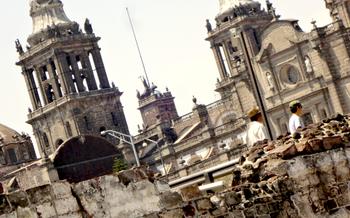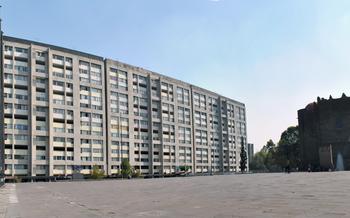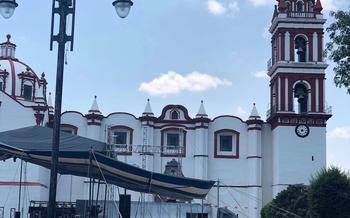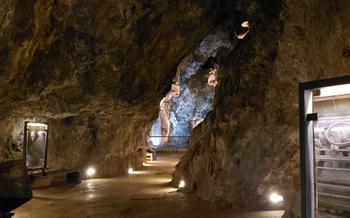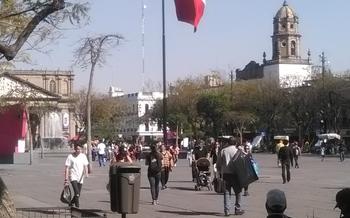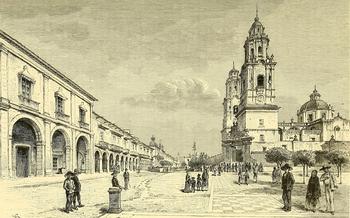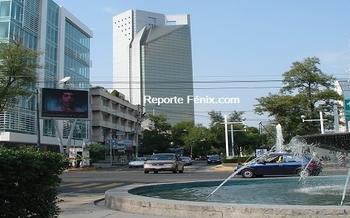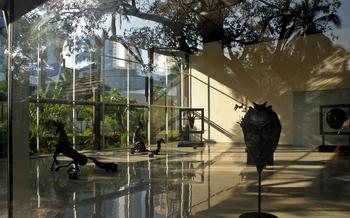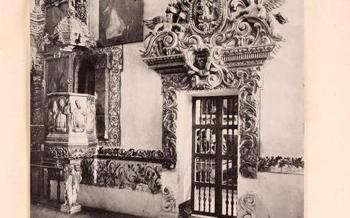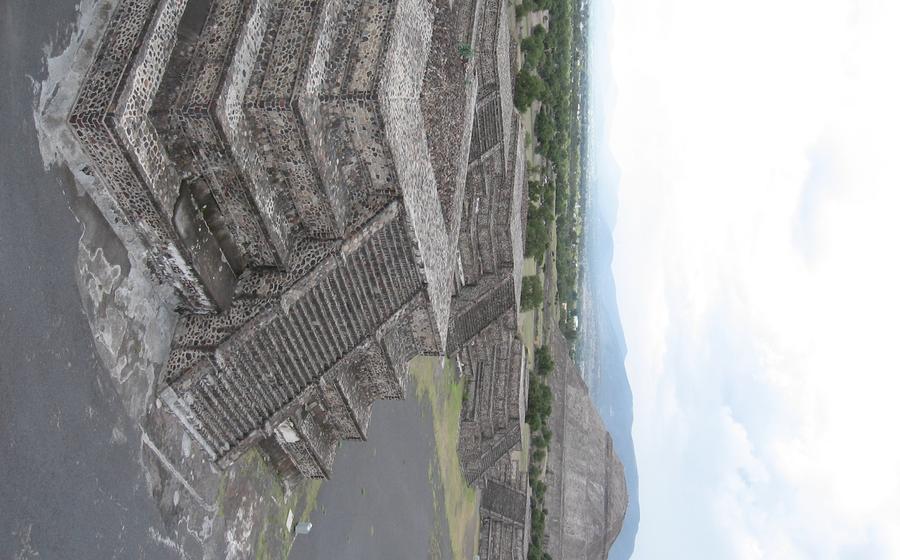
Tlaxcala Cathedral
- The Tlaxcala Cathedral: A Masterpiece of Colonial Architecture
- History of the Cathedral
- Architectural features
- Must-see treasures
- Interesting anecdotes
- Visiting the Cathedral: A Spiritual and Cultural Experience
- Exploring the Interior: A Journey Through History
- The Chapel of Our Lady of Ocotlan: A Pilgrimage Site
- The Diocesan Museum: A Treasure Trove of Religious Art
- Plaza de la Constitución: The Heart of Tlaxcala
- Museo de Arte de Tlaxcala: A Celebration of Contemporary Art
- Mercado Hidalgo: A Taste of Traditional Tlaxcala
- El Rollo: A Symbol of Tlaxcala's Colonial Past
- Casa de Artesanías Tlaxcala: A Showcase of Local Craftsmanship
- Excursions from Tlaxcala: Unveiling Hidden Gems
- Insider Tip: Experiencing Tlaxcala's Culinary Delights
The Tlaxcala Cathedral: A Masterpiece of Colonial Architecture
The Tlaxcala Cathedral, a testament to the fusion of European and indigenous influences, stands as a majestic symbol of Tlaxcala's rich history and vibrant culture. Embark on a journey through time as you explore the cathedral's awe-inspiring architecture, opulent treasures, and fascinating anecdotes, revealing the stories of faith, devotion, and artistry that lie within its sacred walls.
History of the Cathedral
The construction of the Tlaxcala Cathedral began in the 16th century under the direction of Franciscan friars, who sought to establish a grand edifice that would serve as the spiritual and religious center of the newly conquered region. Over the centuries, the cathedral underwent several expansions and renovations, each contributing to its architectural grandeur and artistic richness.
Architectural features
The cathedral's impressive façade showcases a blend of Renaissance and Baroque styles, featuring intricate carvings, delicate moldings, and towering bell towers that pierce the Tlaxcala skyline. Its interior, a testament to the skill and artistry of local craftsmen, boasts soaring vaults, elegant arches, and a profusion of ornate altars, each a masterpiece of Baroque craftsmanship.
Must-see treasures
Among the cathedral's many treasures, the intricately carved altarpiece, a masterpiece of Baroque art, stands out as a testament to the exceptional craftsmanship of the era. The choir stalls, adorned with intricate carvings depicting biblical scenes and mythical creatures, are another must-see, showcasing the artistic prowess of Tlaxcalan artisans.
Interesting anecdotes
One of the most fascinating anecdotes surrounding the Tlaxcala Cathedral is the legend of the Virgin of Ocotlan, a revered figure whose miraculous powers have been attracting pilgrims from far and wide for centuries. The annual pilgrimage to the Chapel of Our Lady of Ocotlan, held on May 8, is a spectacle of faith and devotion, drawing thousands of believers to witness the procession of the Virgin's image through the city streets.
Visiting the Cathedral: A Spiritual and Cultural Experience
Dress code and etiquette: When visiting Tlaxcala Cathedral, respectful attire is expected. Avoid wearing shorts, tank tops, or revealing clothing. Silence and reverence are encouraged inside the cathedral; refrain from loud conversations or disruptive behavior.
Guided tours and audio guides: Guided tours of the cathedral are available in English and Spanish. These tours provide insightful commentary on the history, architecture, and significance of the cathedral. Audio guides are also available for self-guided exploration.
Mass schedules and special events: Mass is held daily at the cathedral, with special masses on Sundays and holidays. Visitors are welcome to attend these services, which offer a glimpse into the spiritual life of the local community. Throughout the year, the cathedral hosts special events such as concerts, exhibitions, and religious festivals.
What to expect during a visit: Upon entering the cathedral, visitors are struck by its grandeur and opulence. The vast interior is adorned with intricate carvings, colorful murals, and stained glass windows that tell stories from the Bible. The atmosphere is serene and contemplative, inviting visitors to reflect on the spiritual significance of this sacred space.
Exploring the Interior: A Journey Through History
Stepping inside the Tlaxcala Cathedral is like embarking on a journey through history, where each element narrates a tale of artistic mastery and cultural significance. The altarpiece, a sumptuous display of Baroque opulence, stands as a testament to the exquisite craftsmanship of the era. Its intricate carvings, adorned with gold leaf and vibrant hues, depict scenes from the life of Christ and the Virgin Mary, creating a celestial spectacle that leaves visitors in awe.
The choir stalls, meticulously crafted from rich mahogany, showcase the artistry of skilled woodworkers. Each stall is adorned with intricate carvings, featuring biblical figures, mythical creatures, and floral motifs. The attention to detail is simply breathtaking, inviting visitors to linger and admire the intricate handiwork.
The stained glass windows, casting a kaleidoscope of colors onto the cathedral's interior, depict biblical scenes and narrate stories from the life of saints. The vibrant hues and skillful artistry create a sense of awe and wonder, transforming the cathedral into a sanctuary of light and color.
The murals, adorning the walls and ceiling, offer a glimpse into Tlaxcala's rich past and its deep connection to Catholicism. These vibrant frescoes depict scenes from the Bible, the history of the church, and the life of local saints, providing visitors with a visual narrative of the region's religious and cultural heritage.
The Chapel of Our Lady of Ocotlan: A Pilgrimage Site
Enshrined within the Tlaxcala Cathedral, the Chapel of Our Lady of Ocotlan holds a profound significance for the people of Tlaxcala and beyond. This sacred site is dedicated to the Virgin of Ocotlan, a revered figure whose legend has woven its way into the fabric of Tlaxcala's history and faith.
The Legend of the Virgin of Ocotlan
According to legend, the Virgin Mary appeared to an indigenous man named Juan Diego Bernardino in the early 16th century. She instructed him to build a chapel on the site of her apparition, and thus the Chapel of Our Lady of Ocotlan came to be. Over time, the chapel became a popular pilgrimage destination for those seeking divine intervention and healing.
The Annual Pilgrimage: A Spectacle of Faith
Each year, on the third Friday after Easter, thousands of pilgrims descend upon Tlaxcala to participate in the grand pilgrimage to the Chapel of Our Lady of Ocotlan. This spectacle of faith draws devotees from across Mexico and beyond, who come to pay homage to the Virgin and seek her blessings.
The Chapel's Interior: A Shrine of Devotion
The chapel's interior exudes an aura of devotion and reverence. The walls are adorned with intricate murals depicting scenes from the life of the Virgin Mary. The altar, resplendent in gold and silver, houses a beautiful statue of the Virgin of Ocotlan, adorned with jewels and offerings from her faithful followers.
The Healing Powers Attributed to the Virgin
The Virgin of Ocotlan is believed to possess miraculous healing powers. Pilgrims come to the chapel seeking relief from various ailments, both physical and emotional. Many claim to have experienced miraculous cures after praying to the Virgin, further solidifying her reputation as a benevolent and compassionate figure.
The Diocesan Museum: A Treasure Trove of Religious Art
The Diocesan Museum of Tlaxcala is a hidden gem that houses a remarkable collection of religious art, offering visitors a journey through the artistic and spiritual heritage of the region. Established in 1977, the museum is housed within the former Colegio de Santa María de la Asunción, a building that dates back to the 16th century.
The museum's collection is a testament to the artistic prowess and devotion of Tlaxcala's artisans and craftsmen. Among the highlights are exquisite paintings, sculptures, and artifacts that showcase various artistic styles and techniques. Visitors can admire the realism of the 17th-century paintings depicting biblical scenes, marvel at the intricate details of the carved wooden figures, and appreciate the craftsmanship of the silver and gold liturgical objects.
The Diocesan Museum not only preserves Tlaxcala's religious heritage but also serves as a space for cultural exchange and education. Temporary exhibitions, workshops, and guided tours provide visitors with a deeper understanding of the significance and symbolism of the artworks. Whether you're a history buff, an art enthusiast, or simply curious about the spiritual traditions of Tlaxcala, the Diocesan Museum is a must-visit destination.
Tips for a Memorable Visit:
-
Plan your visit: The museum is open from Tuesday to Sunday, from 10 am to 5 pm. It's advisable to allocate at least an hour to explore the collection thoroughly.
-
Take a guided tour: Guided tours are available in both Spanish and English, offering insights into the history, symbolism, and techniques behind the artworks.
-
Engage with the museum staff: The museum staff is knowledgeable and passionate about the collection. Don't hesitate to ask questions or request further information.
-
Appreciate the details: Take your time to admire the intricate details of the paintings, sculptures, and other artifacts. Pay attention to the symbolism and iconography often used in religious art.
-
Capture the beauty: Photography is allowed inside the museum, so feel free to capture your favorite pieces and share them with others.
Plaza de la Constitución: The Heart of Tlaxcala
The and soul of Tlaxcala, a vibrant city steeped in history and culture. This central square has witnessed countless events that have shaped the city's identity, from pre-Hispanic rituals to colonial gatherings and modern-day festivities.
The square is surrounded by iconic landmarks, including the Tlaxcala Cathedral, the Palacio de Gobierno, and the Palacio Legislativo, each showcasing a unique architectural style and historical significance. The plaza's central fountain, adorned with colorful tiles and sculptures, serves as a gathering point for locals and visitors alike.
The Plaza de la Constitución is a hive of activity throughout the day. Street vendors offer traditional snacks and handicrafts, while performers entertain the crowds with music, dance, and acrobatics. During special events, the square transforms into a lively stage for concerts, markets, and cultural exhibitions, showcasing Tlaxcala's rich heritage and vibrant traditions.
To truly experience the essence of Tlaxcala, take a leisurely stroll around the Plaza de la Constitución, soak in the atmosphere, and engage with the locals. Whether you're admiring the colonial architecture, sampling local delicacies, or simply people-watching, this central square offers a glimpse into the heart and soul of this captivating city.
Insider tip: Join the locals for a traditional Tlaxcala-style breakfast at one of the many cafés lining the plaza. Savor the flavors of freshly made barbacoa, accompanied by warm tortillas and a steaming cup of coffee, while enjoying the lively morning buzz of the city.
Museo de Arte de Tlaxcala: A Celebration of Contemporary Art
The Museo de Arte de Tlaxcala (MAT) is a haven for art enthusiasts, showcasing a diverse collection of contemporary Mexican art. Housed in a beautifully restored 18th-century building, the museum offers a unique blend of historical charm and modern artistic expression.
The MAT's collection boasts works by renowned Mexican artists, such as Diego Rivera, José Clemente Orozco, and David Alfaro Siqueiros, as well as emerging talents. Visitors can admire a variety of artistic styles, from traditional Mexican folk art to abstract expressionism and conceptual art.
Temporary exhibitions and special events add to the museum's vibrant atmosphere, providing a platform for emerging artists to showcase their work and engage with the local community. Visitors can attend workshops, lectures, and art demonstrations, gaining insights into the creative process and the diverse artistic landscape of Mexico.
To make the most of your visit, take advantage of the guided tours offered by the museum. Knowledgeable guides will provide historical context and insights into the artworks, enhancing your appreciation of the collection. The museum also has an audio guide app, allowing visitors to explore at their own pace and learn more about the featured artists and their works.
Mercado Hidalgo: A Taste of Traditional Tlaxcala
Located in the heart of Tlaxcala city, Mercado Hidalgo is a bustling marketplace that offers a vibrant glimpse into the city's culinary traditions and local life. The market has existed since the pre-Hispanic era and has served as a central hub for trade and commerce throughout Tlaxcala's history.
As you step into the market, you'll be greeted by a symphony of sights, sounds, and aromas. Vendors proudly display their wares, from colorful produce and fragrant spices to handmade crafts and traditional textiles. The air is filled with the smell of freshly cooked food, as vendors prepare local delicacies such as barbacoa, mole poblano, and pulque.
Strolling through the market, you'll find an array of stalls selling everything you could possibly need. There are sections dedicated to fresh produce, where you can buy seasonal fruits and vegetables directly from local farmers. There are also sections for meat, seafood, and dairy products, as well as stalls selling traditional Mexican sweets and snacks.
In addition to food, Mercado Hidalgo is also a great place to find handmade crafts and souvenirs. You can find everything from intricate pottery and textiles to colorful baskets and wooden carvings. Many of the items are made by local artisans, so you'll be supporting the local economy when you make a purchase.
Mercado Hidalgo is more than just a place to buy and sell goods. It's also a vibrant social hub where locals come to meet, chat, and share stories. As you wander through the market, you'll see people of all ages and walks of life interacting with each other, creating a lively and welcoming atmosphere.
To fully experience the essence of Tlaxcala, a visit to Mercado Hidalgo is a must. It's a place where you can immerse yourself in the city's culinary traditions, support local artisans, and connect with the local community. Whether you're looking for fresh produce, delicious food, or unique souvenirs, Mercado Hidalgo has something for everyone.
El Rollo: A Symbol of Tlaxcala's Colonial Past
El Rollo, an iconic monument in the heart of Tlaxcala, stands as a silent witness to the city's rich colonial history. Built in the 16th century, it originally served as a whipping post, a grim reminder of the harsh punishments meted out during that era. Today, it has been repurposed as a symbol of justice and reconciliation, a testament to Tlaxcala's journey from a colonial outpost to a modern, progressive city.
Architecturally, El Rollo is a fascinating blend of Spanish and indigenous styles. Its four sturdy columns support a domed roof, while intricate carvings and reliefs adorn its surface. The monument's design reflects the fusion of cultures that shaped Tlaxcala's identity during the colonial period.
El Rollo's current role as a symbol of justice and reconciliation is particularly poignant. It serves as a reminder of the city's complex past, while also representing its commitment to upholding justice and promoting peace. Tlaxcalans take great pride in this monument, which has become a beloved landmark and a source of inspiration for future generations.
To fully appreciate El Rollo's significance, visitors should take the time to admire its intricate details and reflect on its historical importance. It is best viewed in the early morning or late afternoon light, when the shadows cast by its columns create a dramatic effect. Be sure to capture some memorable photos to immortalize your encounter with this unique monument.
Casa de Artesanías Tlaxcala: A Showcase of Local Craftsmanship
Tucked away in the heart of Tlaxcala city, the Casa de Artesanías Tlaxcala is a treasure trove of local craftsmanship and a testament to the enduring skills of the region's artisans. This vibrant center is dedicated to promoting and preserving the rich traditions of Tlaxcala's crafts, ensuring that these skills continue to thrive for generations to come.
Visitors to the Casa de Artesanías will find an array of exquisite handmade goods, each a testament to the artistry and dedication of the local artisans. From intricate textiles and colorful pottery to finely carved wooden crafts and delicate jewelry, the center offers a diverse collection of unique and authentic souvenirs.
One of the highlights of the Casa de Artesanías is the opportunity to witness skilled artisans demonstrating their techniques and sharing their knowledge with visitors. These demonstrations provide a fascinating glimpse into the creative process and offer a deeper appreciation for the time and effort that goes into each handcrafted piece.
For those who wish to delve deeper into the world of Tlaxcala's crafts, the center also offers workshops where visitors can learn from the masters and try their hand at creating their own unique souvenirs. These workshops are a wonderful way to connect with the local culture and create lasting memories of your visit to Tlaxcala.
When visiting the Casa de Artesanías, be sure to take your time to browse the diverse collection, chat with the friendly artisans, and find that perfect souvenir to cherish as a reminder of your time in this vibrant and creative city. Supporting local artisans not only ensures the preservation of traditional crafts but also contributes to the economic and cultural well-being of the community.
Excursions from Tlaxcala: Unveiling Hidden Gems
Venturing beyond the city of Tlaxcala unveils a wealth of hidden gems waiting to be discovered. History buffs can delve into the past at nearby archaeological sites like Cacaxtla and Xochitécatl, where ancient civilizations left behind impressive ruins and artifacts. For those seeking a touch of magic, the nearby towns of Huamantla and Atlihuetzia offer a glimpse into Mexico's enchanting traditions, colorful festivals, and well-preserved colonial architecture.
Nature enthusiasts will find solace in the UNESCO Biosphere Reserve of the Malinche Volcano, with its breathtaking landscapes, diverse flora and fauna, and opportunities for hiking, camping, and mountain climbing. To fully immerse yourself in the natural wonders of the region, consider visiting the Santa Maria del Monte National Park, renowned for its stunning waterfall and lush vegetation.
When planning your excursions, it's essential to consider the distance, transportation options, and time required for each destination. Guided tours are available for many of these attractions, providing a convenient and informative way to explore. Alternatively, renting a car offers flexibility and the freedom to create your own itinerary.
Remember to pack comfortable shoes, sun protection, and a camera to capture the beauty of these hidden treasures. Whether you're a history buff, nature lover, or simply seeking a unique cultural experience, the excursions from Tlaxcala promise unforgettable adventures that will enrich your understanding of this diverse and captivating region.
Insider Tip: Experiencing Tlaxcala's Culinary Delights
Tlaxcala's rich culinary heritage is a delight for food enthusiasts and a testament to the region's diverse agricultural traditions. Among the must-try dishes is Tlaxcala-style barbacoa, a traditional slow-cooked lamb or goat meat served with a flavorful sauce. Mole poblano, a complex and aromatic sauce made with dozens of ingredients, is another must-sample delicacy. And don't forget to try pulque, a traditional fermented beverage made from the sap of the maguey plant.
For an authentic dining experience, head to La Casona de la Quinta, a charming restaurant housed in a beautiful colonial-era building. The menu features a variety of traditional Tlaxcalan dishes, including barbacoa and mole poblano. La Casa de las Sirenas is another great option, offering a unique culinary experience in a magical setting.
Street food stalls and local markets are also great places to sample Tlaxcala's culinary delights. Look for stalls selling tacos, tamales, and other local specialties. Don't be afraid to ask locals for recommendations and tips.
Tlaxcala's cuisine is not just about delicious flavors; it's also about preserving and celebrating the region's cultural heritage. By savoring the local dishes, you'll gain a deeper appreciation for Tlaxcala's unique identity and the hard work of its people.
